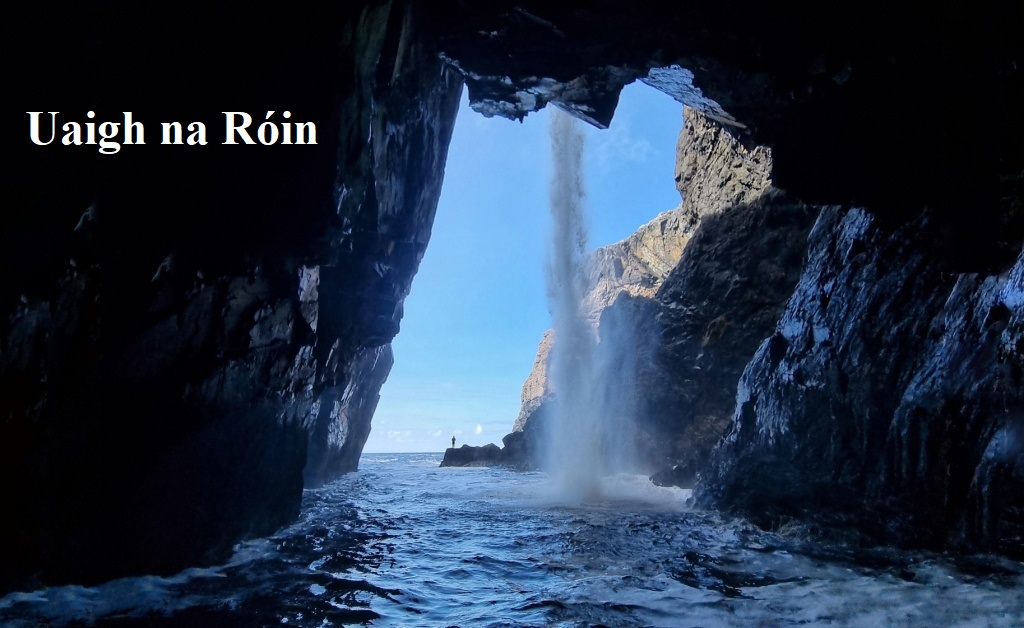
It was the mid-1990s; I was in Sharkeys Bar in the wee village of Anagaire in Western Donegal. It was around midnight on a Saturday night. By dim light, with smoke in the air, I was sitting on a creaky high bar stool listening to several stories about a sea cave in Donegal. It was said to be over a mile long and had a roof so high you could not see it even with the best of oil lamps. I was told it was possible to row your boat through the cave with entrances from both the north and the south, and in the main cave lived hundreds of seals. It was a cave not regularly visited by local fishermen as it was said to be the home of the Chéile Séala. The Chéile Séala (or Selkies) are seals that are said to shed their pelts and take a human form. They were greatly feared by sailors when they were in their human form. They were said to lure sailors into the sea, and with a visit to Davy Jones Locker, the sailors would drown. The drowned sailor then becomes a resident of Mr Jones’s Locker, they are then said to be reborn and join the Chéile Séala. The cave being spoken about was the little-known Uaigh na Róin, or The Cave of the Seals.
All the listeners and, indeed, the storyteller were perhaps a little tipsy at this late hour, and I was pretty sure the tales were tall but I did listen to every word spoken.
Living on the southwest coast of Árainn Mhór just off western Donegal lives Poll an Reithe. Poll an Reithe is simply a massive hole in the ground sometimes known locally as the blowhole. The main section of this hole is a massive circular chamber about 40 meters in diameter and 50 meters in height. You can see this when you look down into the hole from above.
In July 2021, I was out on Árrain Mhór with my seven year old son Luke and we paid a visit to the base of Poll an Reithe. We roped up on the summit and made our way down the steepness to the very rocky floor of Poll an Reithe. We had a good look about the boulder field and quickly found a superb wee dark tunnel, which we followed through the darkness for 80 or so metres. This took us to a south-facing storm beach looking out towards Sliabh Tuaidh. We boulder hopped out to a very tidal island and had our lunch in this outrageous wee spot surrounded by high crumbling cliffs above the four bull selkies playing in the waves. As soon as we began to fear being stranded on our little island we started our return journey I was whilst we were scrambling up the steep grassy slopes out of Poll an Reithe. I had a moment of total recall and crystal clear clarity back to the late evening stories from nearly 30 years ago.
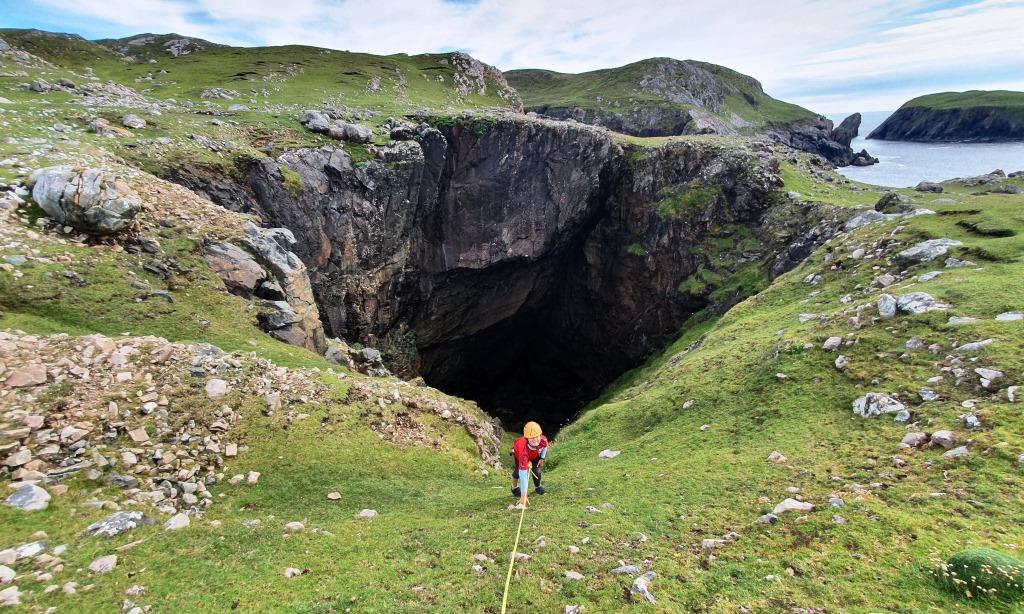
Luke making the descent into Poll an Reithe.
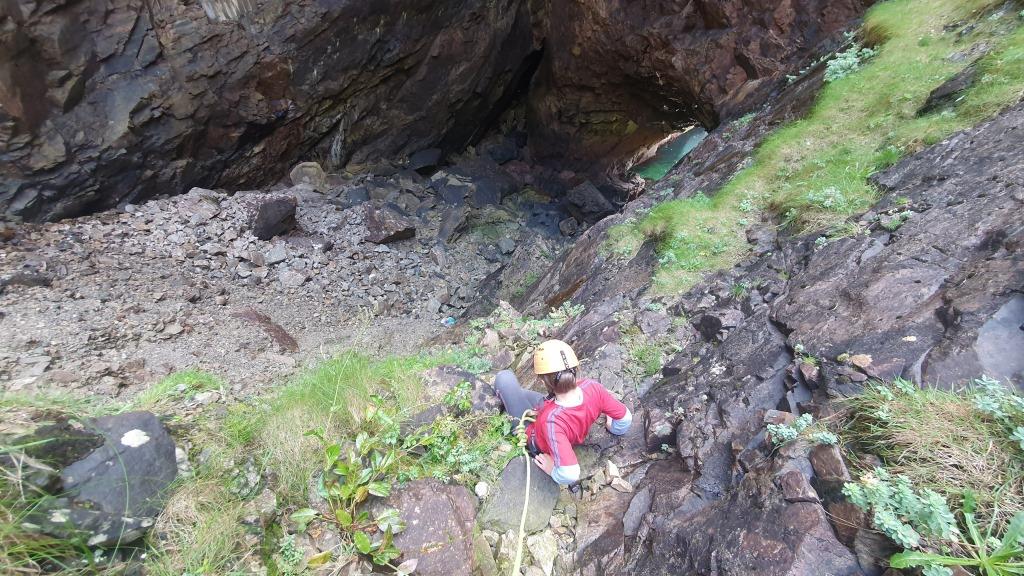
The final step to the bottom of Poll an Reithe
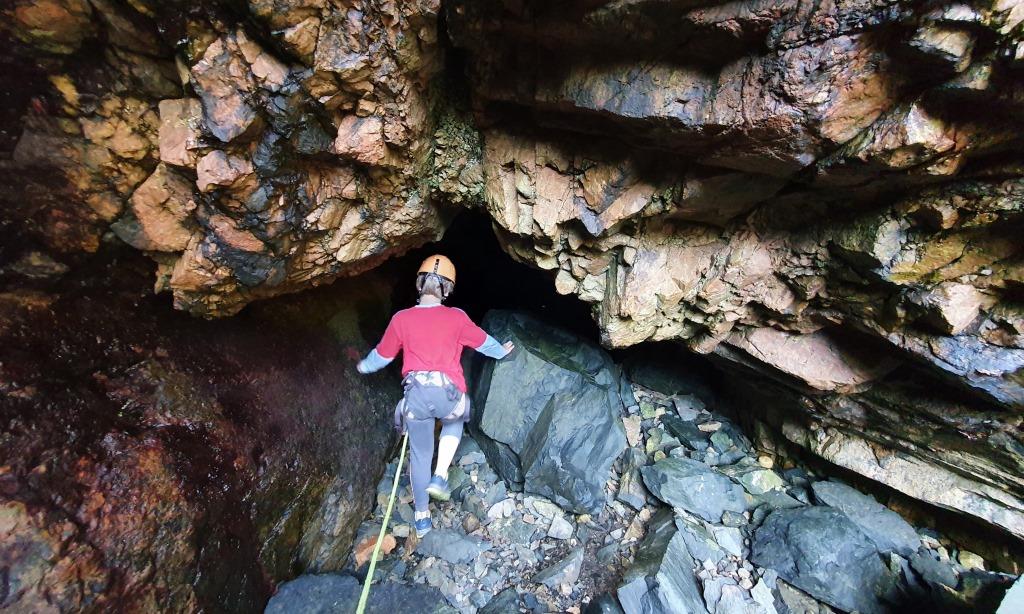
The connecting tunnel between the main chamber and the southern storm beach.
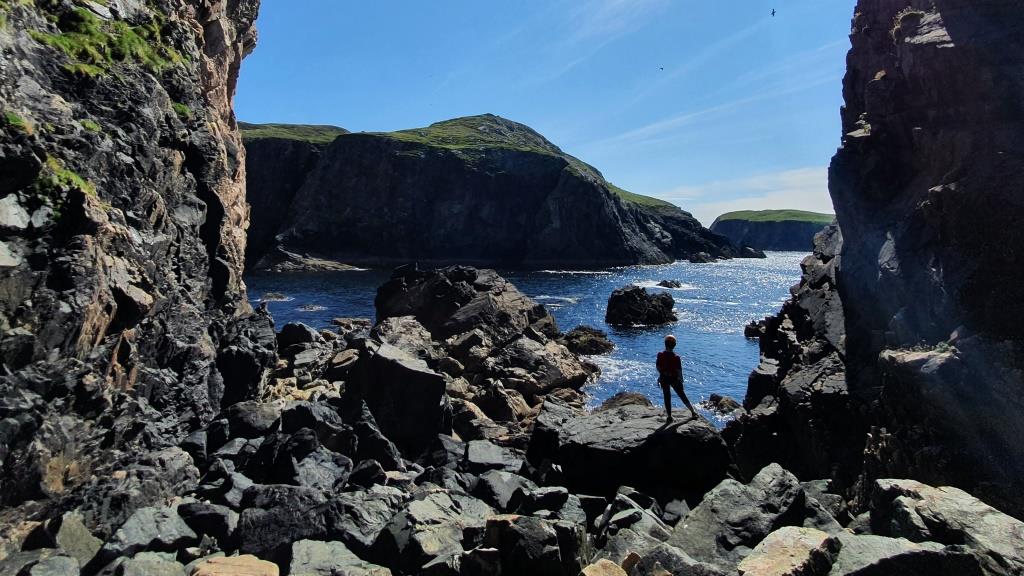
The Southern Storm Beach
July 2023 and once more I was standing above Poll an Reithe looking down into the abyss. I was with Lisa Murdiff, a small inflatable boat, a half-ton of ropes, climbing/caving, and various nautical toys. The cunning plan was to link Poll an Reithe and Poll a'Chopper but at this point I was not sure what was involved or even if they did link. Would we need to abseil, climb, swim? The possibility of mishaps whilst underground can not be taken lightly. This was the reason for a vast collection of toys, as venturing into the unknown always involves a considerable amount of managing concerns and judging the what-ifs' real and the imagined types.
We spent the next hour or so walking the clifftops of Poll a'Chopper, looking down at our potential cave exit point behind the spectacular free-falling waterfall. We paced the cliff tops and hillside, trying to measure the possible size and shape of underground chambers where we were going. We discussed through a few dozen possibilities of what lay underground and what we needed to bring with us, so we began the descent into Poll an Reithe.
Our journey began with a little steep downclimb onto the grassy rake in the upper section of Poll an Reithe. This initial section was not tricky terrain as it was an easy downclimb to a steep grass rake. A slip here would have more than likely resulted in a considerable fall and death onto the rocky debris below. From the top of the steep grass, we carefully made our way down a loose rock ridge, which took us to the top of a horrendous scree descent into the darkness far below. A static was rigged, and its free end was thrown down into the abyss; we then descended a single file down into the semi-light of the cavern zone below.
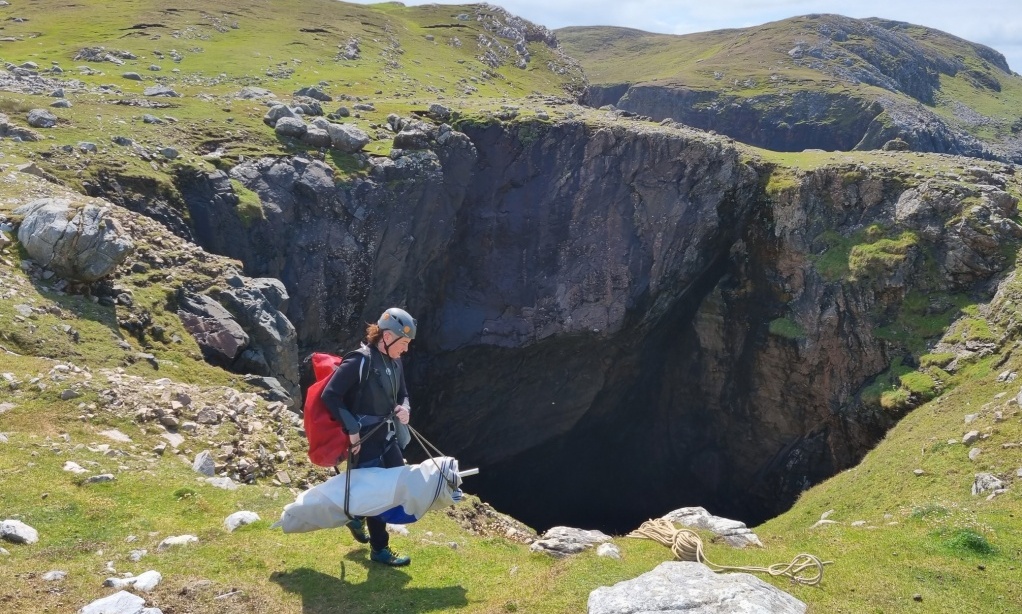
Lisa carrying our mighty vessel into Poll an Reithe.
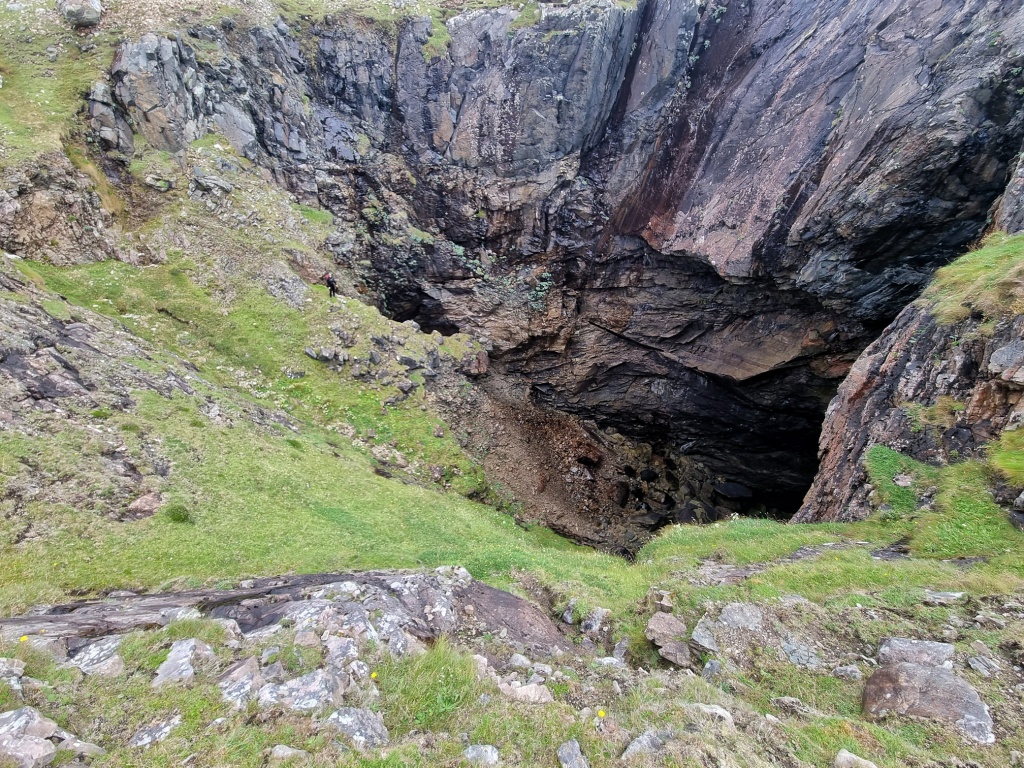
Lisa looking small in Poll an Reithe.
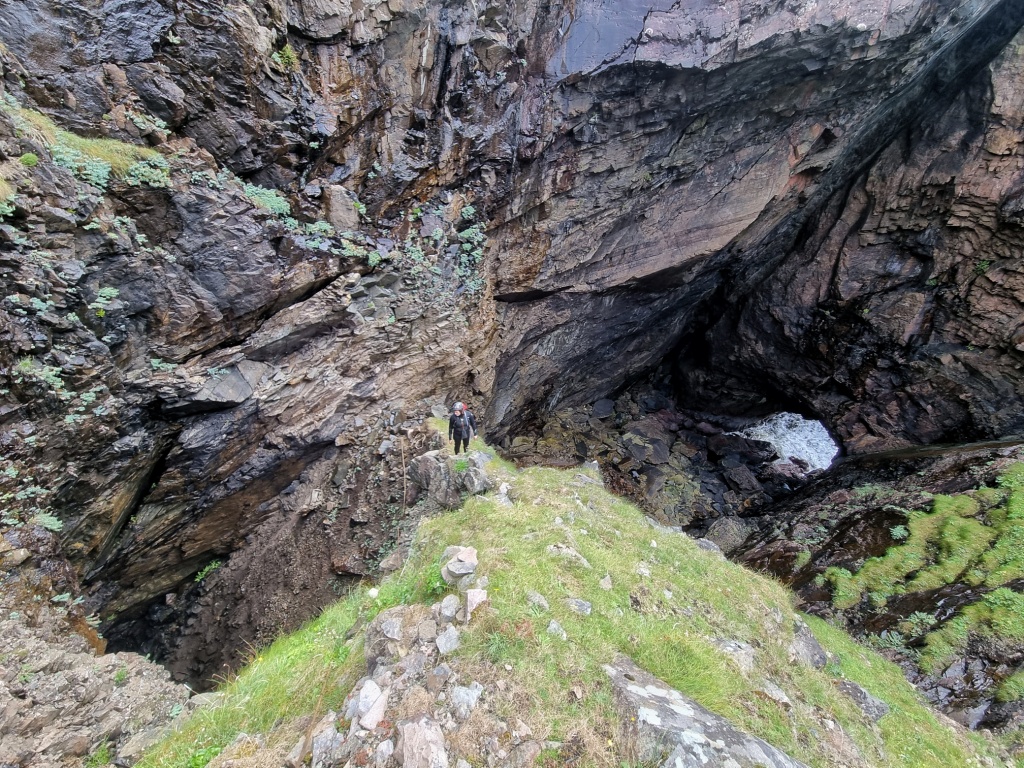
Lisa in Poll an Reithe on her left is the descent down to sea level in Uaigh na Róin.
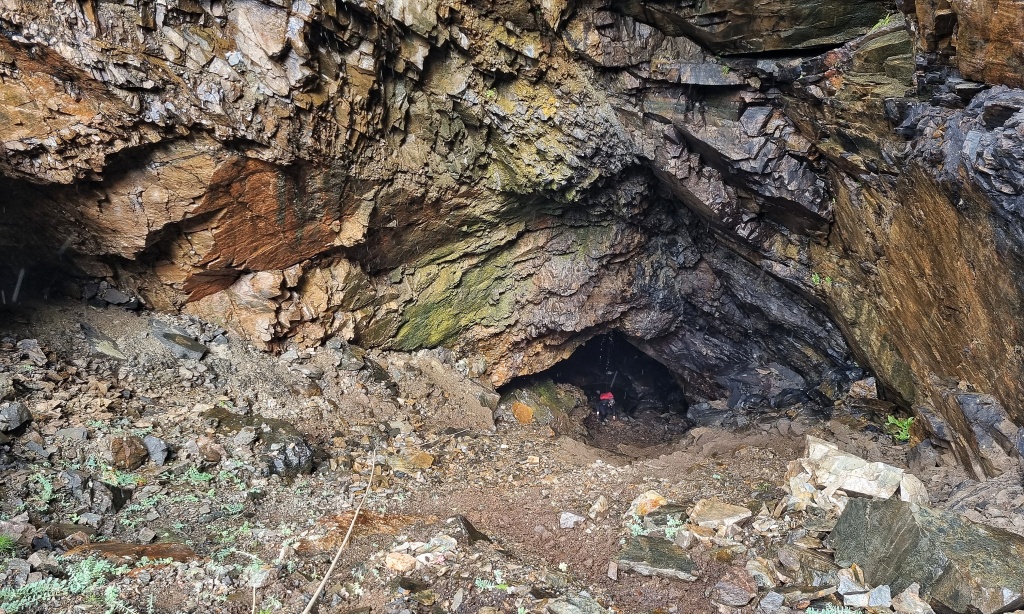
The descent down to Uaigh na Róin
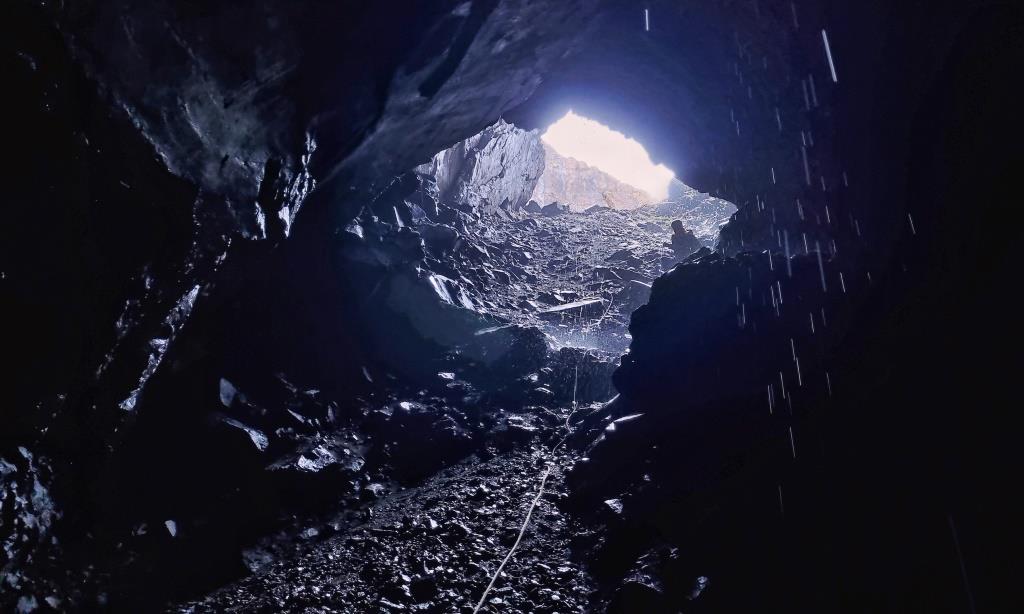
Looking back up from the base of the descent
The loose horror show of a descent had taken us to a rocky wee storm beach at sea level. We were looking out into a vast sea cave through our head and hand torches with a beam of daylight shooting across the middle distance into the darkness. We inflated our mighty vessel and paddled into the darkness. At first, we were in a smaller chamber, which quickly opened into the much larger main chamber, and to our left was an 80-meter-long tunnel leading to the back of the waterfall in Poll a'Chopper. We paddled the full length of the main chamber to the far northern end and a much larger pebbled storm beach. Walking around on this much more extensive storm, our headlamps illuminated the active rock calving high on the chambers ceiling. We paddled away from the storm beach and the boulders of Damocles hanging high above our heads. We paddled into a smaller and darker chambered recess, which took us around 50m deeper away from the exit light. In this much smaller recess on the tidal ledges on either side of us, we met several mothers resting with a good number of last year's pups playing in the gently lapping sea between the boulders. We did a U-turn and paddled the 130 meters to arrive into daylight at the back of the spectacular free-falling waterfall and Poll a’chopper. We landed the mighty vessel on the rock tongue at the base of the mother of all arêtes. A month or so later, Yosef Dvores and Stephen "Jock" Read got the first ascent just as winter weather was arriving. The ascent of this arete gives Árainn Mhór the third and final piece in its trifecta of world-class coastal rock climbs. For more information Click for more Information HERE The tongue of rock we were standing on, in the center of Poll a'Chopper was a truly outrageous place to be. On our right, we had the 35m high free-falling waterfall thundering down over the mouth of Uaigh na Róin entrance. Around this splash zone of the waterfall, Bull Selkies rolled and tumbled in the wash of the waterfall. To our left was the mouth of a huge black sea cave, and every so often, there was a pop and a huge rush of air from the black dark cave. Around us on three sides were the huge, steep, overhanging, rotten sea cliffs of Poll a'Chopper. The only way we could escape our current location was a 1km swim around the southern headland to the southern cave entrance or return the way we came. We left our outrageously beautiful location and began the return journey.
A short film of our visit to Uaigh na Róin
The purpose of this most excellent adventure was simply to map out, as best I could, what I strongly suspect would have been one of Ireland's largest sea caves. If we travel back in time to before the roof collapse that created Poll an Reithe. At this time, it would have been possible to paddle into the southern sea cave into the vast cavern that would become Poll an Reithe. This egg on its side-shaped cavern would have been about 70m by 50m and about 50m high. It would have been possible to continue paddling in darkness now in the cave zone. This would have taken you into Uaigh na Róin and out behind the waterfalls in Poll a'Chopper.
The cave system I have mapped out is what our storyteller said it would be. The description of the cave shape and dimensions were perfect, with the cave mouths at both the north and the south ends. The cave ceiling height throughout would have been in the 40 to 50m range in the Poll an Reithe chamber. The complete underground sea passage would have been around 600m long. It is safe to say that in a boat with oars and hand-held oil lamp lights, that distance would have seemed like miles in the dark underground. The entire cave system would have been crucifix-shaped, with the 500 to 600-meter-long central passage being Poll an Reithe and Uaigh na Róin combined. This central passage would have run in a rough north-to-south direction. The smaller passage crossing the main would have run for about 120 meters from Poll a'Chopper to the back of the recess with the resting seal mothers. There was no throughput of air at the far ends of each cave and I don't think they join to the enormous cave next door in Poll a'Chopper. I believe that with the size and scale of the blocks above the big storm beach, It will not be long before it enters the next sea cave or creates another monster blowhole. In geographical time scales, it is not long, maybe in the next thousand or so years.
I spend approximately 100 days a year kayaking around the islands of western Donegal. In this particular stretch of Árainn Mhór coastline down to Stac an Iolar, I have met and paddled with these seals before. I have observed the bull selkies playing in four different caves in this area on previous visits to the island. My 100s of interactions with seals whilst kayaking over the years have always been the same. They will always watch you for a bit, then swim around your boat until they get bored, and then they leave. Our time in Uaigh na Róin was no different. The seals in the water swam around our boat, and others just watched. The Bull Selkies swimming and rolling around the waterfall wash ignored our boat as the waterfall was much more entertaining.
Places like Uaigh na Róin have long histories both geographically and with humans. Its human history goes back many hundred years to the islanders fishing the coast around their island. Their knowledge of the weather, seas, tides and coastal features would have been extensive as their lives depended on it. In modern times, Poll a'Chopper, with its caves and waterfall, is occasionally visited by experienced sea kayakers on their circumnavigation of Árainn Mhór.
Alas, our storyteller is no longer with us, but I am forever grateful to be able to overhear his stories that night nearly 30 years ago.
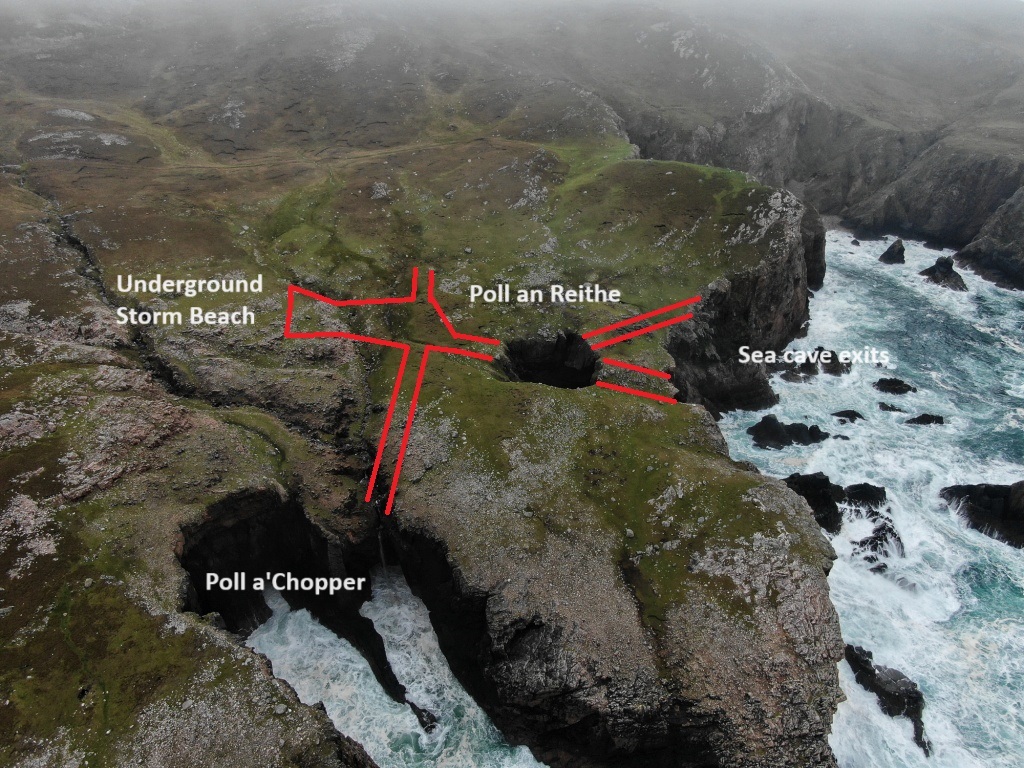
Plan view of the connected cave system between Poll an Reithe and Uaigh na Róin
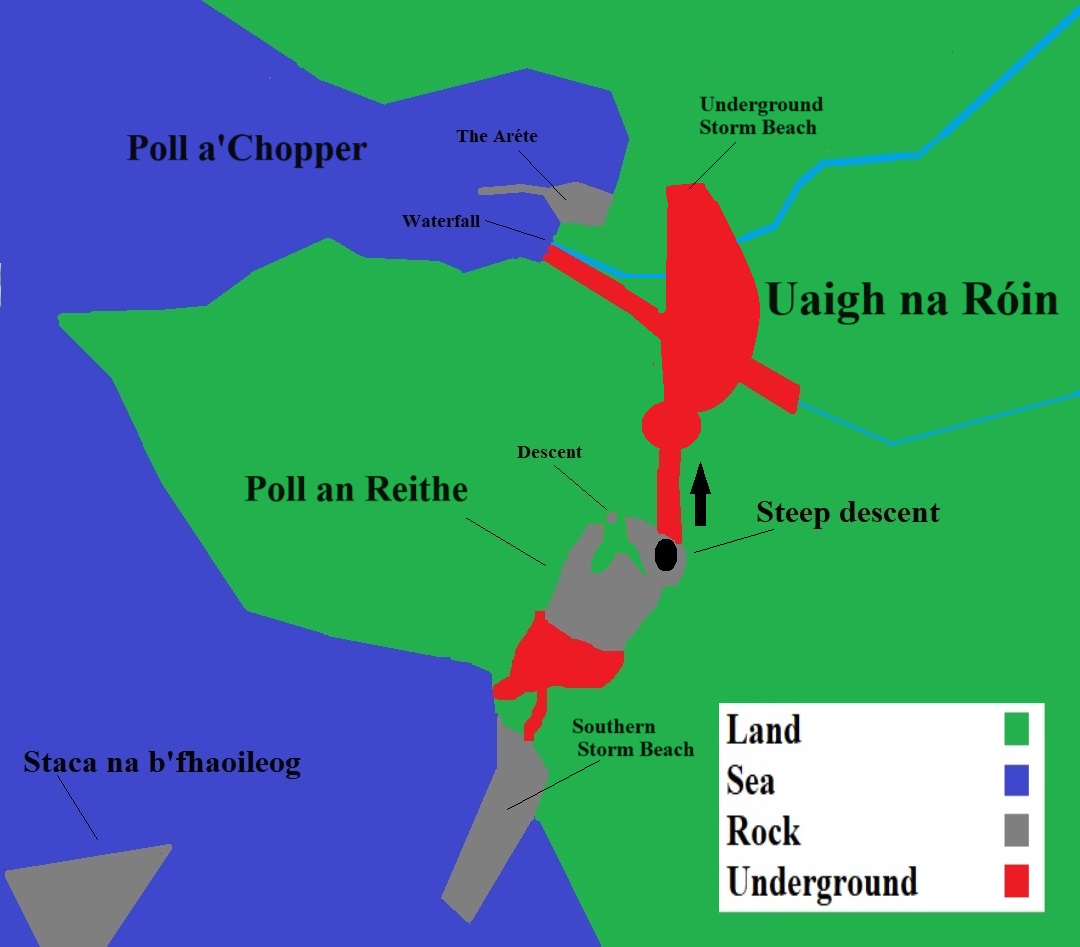 The Cave system of Uaigh na Róin
The Cave system of Uaigh na Róin

The view from Uaigh na Róin looking toward The US of A